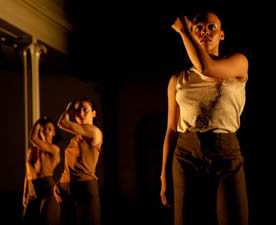Each year, the American Dance Festival brings, along with the famous and established, at least one company of young talent, and usually those companies and their choreographers turn out to be artists we will hear from again and again. This year the ADF introduces to this area the dynamic Kyle Abraham, who is presenting his 2010 work, The Radio Show, which derives from his life experience of listening to two particular “black” radio stations in his hometown of Pittsburgh.
The kind of connection with radio that Abraham glorifies lies largely outside my personal cultural experience, but he makes its importance, even centrality, clear enough. In a program insert, he wonders: “Without black radio, where is the audible voice of the black community?” and “Is radio fading away? Are we still listening?” In the dance itself, he looks at remembering and forgetting, in the body of an aged figure he dances (representing his own father, diagnosed with Alzheimer’s), who wanders through the bright dance pictures, struggling to understand and speak. The dance begins, and is punctuated with, bursts of actual connection with the audience in Reynolds Theater. The music starts — the “Preshow” — well before the action, but suddenly Kyle Abraham appears in the side aisle with an irresistible smile and pulls a woman from her seat for a quick spin. A few others get the same treat before Abraham bounds onto the stage. Later, assistants facilitate audience “call-ins” to a live “on-air” talk show.
In The Radio Show, the music and the talk, the interrupted reception and static, the station identifications and the off-the-air bleeping, are all part of the fabric of life. Certain songs evoke particular moments or stages of one’s life-dance. Life on the stage is lived to a fabulous music mix ranging from classic soul and gospel to recent hip-hop, and whether the dancers are falling in love, falling out of love, fighting, praying or simply keeping on from day to day, their bodies glow with electric life.
The choreography got slightly repetitive, a few sequences seemed burdened by their length, there was perhaps a bit much static, and there were several too many instances of sudden blinding flashes of light projected into the audience, but none of this could irritate. Watching the sinuous, self-regenerating motion was like receiving a powerful transfusion. Every spiral and elastic leap, every out-flung arm, offered a life-line. Admittedly, I needed a positive energy transfer, having been ambushed by a tragic death a few hours earlier. But I believe the idea of radio representing a life-line is the point of The Radio Show. Radio’s voice forms a thickly twisted line, connecting souls unknown to each into a community. Abraham’s dance does the same, one theater at a time.












